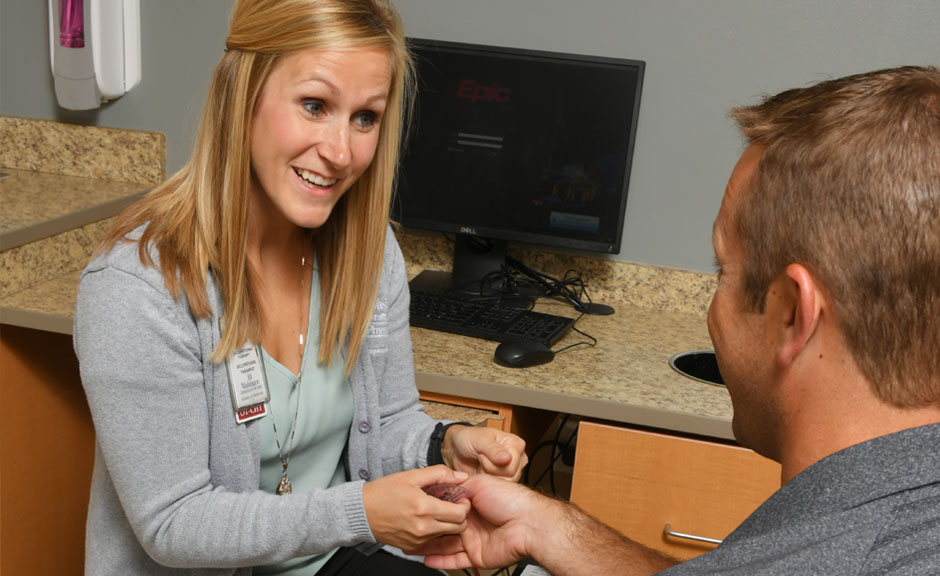Team-based care with certified hand therapists
Collaborative approach at Milliken Hand Rehabilitation Center enhances long-term positive outcomes for hand patients
by Stephanie Stemmler • November 12, 2019

Stacy Baker, MOT, OTR/L, CHT, uses a goniometer to assess a patient’s range of motion in his rebuilt thumb.
For more than 60 years, the Program in Occupational Therapy has been part of a comprehensive hand rehabilitation program at Washington University School of Medicine that provides treatment for patients with hand and upper extremity injuries and abnormalities. Within the Milliken Hand Rehabilitation Center are certified hand therapists who are either occupational or physical therapists and who collaborate with orthopedic and plastic surgeons, as well as referring physicians. The center is one of the oldest in the country and one of the busiest in the region.
“We log an average of 1,100 to 1,200 patient visits monthly in two locations,” says Patricia Nellis, OTD, OTR/L, director of clinical operations for Washington University Occupational Therapy. “From our program, we have 16 therapists, with almost all having advanced certification as hand therapists.”
Nellis has a long-standing interest in the benefits of team-based, integrated health-care delivery models, and she notes that the collaborative approach in the Milliken Hand Rehabilitation Center is responsible for enhancing long-term positive outcomes for hand patients.
“It’s not a common model, but true team-based care in practice is when we all communicate, collaborate and work together for a common goal, which is to improve care and enhance recovery for the patients we see,” she says.
In the hand center, occupational therapists are involved throughout the full continuum of care — from pre-surgery through post-surgery and then follow-up care after the patient returns home. All are highly skilled and trained in anatomy and physiology, as well as surgical protocols for each procedure and individual surgeon.
To enhance their knowledge base, they also observe surgeries.
In the clinics, pre-surgical visits are focused on education, exercises and precautions for each patient. “We work closely with each physician and make recommendations to them related to how therapy needs to flow both before and after surgery,” says Stacy Baker, MOT, OTR/L, CHT, a certified hand therapist at Milliken.
Baker partners with Charles A. Goldfarb, MD, Professor and Vice Chair of the Department of Orthopedic Surgery and co-chief of the hand and microsurgery service at Washington University School of Medicine, for the care of patients needing hand therapy and care.
Goldfarb says the expertise and the knowledge base of a trained hand therapist is vital to patient recovery and maximization of function. In fact, hand therapists must have an equal seat at the table for optimization of patient care.
“For complex issues such as tendon injuries, birth anomalies, or challenging fractures of the wrist and hand, therapist involvement is a must,” he says. “Knowing when to increase therapy loads or forces, when to slow down, when to add modalities — these are not well defined in the literature and depend on therapist experience and therapist-physician interaction. This relationship and the complementary skill sets and knowledge base are so critical for the best patient outcomes.”
“Physicians, nurse practitioners, therapists and the staff are all on the same page, with the same plan and same goals,” stresses Nellis. “Patients may all see us separately, but we are located in the same place, and there’s tremendous value in that model.”
Especially with health-care reimbursements increasingly focused on outcomes and prevention of readmissions, Goldfarb notes that team-based care is at the forefront of where health care needs to be.
“The daily interaction between the patient, Stacy and myself is vital,” he explains. “Our clinic is filled with complex patients, and having a knowledgeable partner whose experience and skill is additive to my own is amazing. I depend on Stacy for patient assessment and planning, whether for nonsurgical care, surgery or postoperative management. Ultimately, the biggest benefit is that the patient receives the best possible care.”
Nellis agrees. “In our center, we have a seat at the table. We make recommendations, are asked for opinions on therapy strategies, and are truly collaborating with physicians,” she says. “Everyone working together helps to ensure that a surgeon’s surgical outcomes are good because there is appropriate pre- and after-care.
“Frankly,” she adds, “if you are not engaged in team-based, collaborative care where you practice, your patient won’t benefit as much. Patients don’t live in silos, and delivering health-care services does not happen in them either.”
